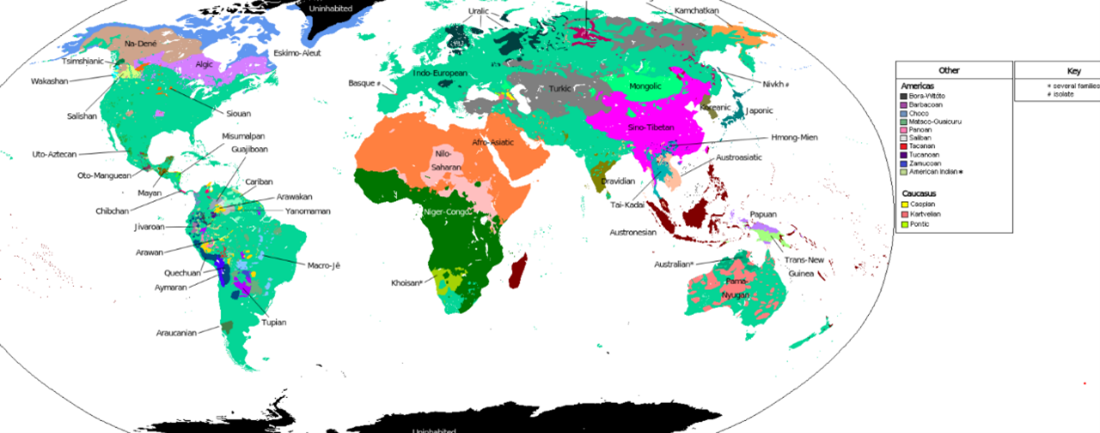Chinese translation is quite hazardous, which leads to repeated conflicts between China and the West. The root cause of this issue lies in the concept of language families. Due to the language family situation, Chinese cannot be translated into English using typical strategies, unlike translations between English and Russian or English and Hindi. When a translation is attempted using a traditional approach,* it often results in huge misunderstandings that boil over into conflicts. In this article, I’ll be discussing what language families are and demonstrating how overlooking them has pushed our world to the brink of nuclear war. To avoid offending anyone politically, I’ll also blame this issue on the United States government, but I’ll be ambiguous as to whether Democrats or Republicans are to blame.
Indro-European vs. Sino-Tibetan Language Families
We usually think of language as something drawn on national boundaries, as one famous linguist once remarked that the difference between a dialect and a language is that a language has its own navy and an army. In a contrary vein, famed political scientist Samuel Huntington proposed that major post-Cold War conflicts would occur along several major cultural groups in his “Clash of Civilizations” theory. Interestingly, however, the two “clash of civilizations” conflicts that have fully absorbed the United States’s attention since the Cold War have been, firstly, the conflict with the Muslim World, and the long-awaited but more recent conflict with China. What interests me here is that these are two cultural groups identified by Huntington as belonging to major language families classified as “Class 4” difficulty by the US State Department. If you look at the excellent language families map created by the folks at Wikimedia, you can see where these lines are drawn quite neatly:

Since this is a blog about Chinese-to-English translation, I want to focus on the China-West conflict. To understand the global problem, however, it’s essential to first look at civilizational conflict outside China. Much of the conflict with the Arab world has revolved around a fictional Muslim boogeyman that threatens to annihilate Western civilization. What’s more, Arabic linguists have meticulously pointed out that the immense misunderstanding the West has about the Arab world arose through translation. If you inspect the map, you will notice that the Arab peninsula is an independent language family. Compare the situation to other distant countries such as India and Russia. Despite being immensely distinct culturally, a shared language family enables translation to proceed without insurmountable challenges. The current conflict with Russia is underlined by the admiration expressed by Fox News commentators for Russia. The State Department lists languages by their difficulty, and the “Class Four” category—the hardest—is exclusively occupied by other language families—Japanese, Korean, Arabic, and Chinese. All four of these civilizational groups have experienced conflicts that threatened to escalate into nuclear war.
The United States actually invaded and occupied countries from three of these groups and attempted to use “transformational diplomacy” to transform what it saw as a dangerous culture: Japan, Korea, and Iraq. While the United States never did this in China, it did threaten a nuclear attack on China in the 1950s, which persuaded China to acquire a nuclear arsenal of its own. Statistically, the probability of the United States threatening nuclear war or corrective military occupation, according to language class, is as follows:
| Language Class | % US Attack Chance |
| I | 0% |
| II | 0% |
| III | 13% |
| IV | 100% |
The main difference between a Class III and Class IV language is that all of the Class IV languages have their own language family where the unique linguistic tradition is particularly strong. A case might be made to include Vietnamese and Thai as Class IV languages, in which case it’s relevant to point out strategies similar to those used in Japan were deployed in occupied Thailand and Vietnam. My argument here is that a US-China nuclear war is not inevitable, but only if the social practices driving the nuclear war risk are curtailed.
A key language family factor that raises the stakes of nuclear war, and makes Hindi-to-English translations look so clear compared to the often nonsensical Chinese-to-English translations, is the fact that the languages share a common heritage and that relatively unskilled translators can use the commonality between the two languages to provide useful translations. Based on this, I want to emphasize that translations involving the Class Four languages—which have their own language family memberships distinct from Indo-European—exist in a danger zone, and this danger zone accounts for the “clash of civilizations” narrative that has played out in international relations.
The danger zone is particularly relevant to corporations at foreign regulators’ whims: whether to a company like H&M being banned in China for having said the wrong thing in translation, to the US and China who have gotten close to real violence also based on things gotten wrong in translation.
China: No Such Thing as “Translation”
Scholars of translation have pointed out that China and Japan traditionally have no such practice as “translation” (in the sense of the English word). Rather, they had transcoding practices known as Geyi that, if applied to Chinese>English translation, result in that wonderful gibberish known as “Chinglish.” Any Chinese native speaker can verify this by looking up the Heart Sutra online—the same one used by Buddhist temples across China today. To a Chinese native speaker lacking special training in this type of text, it makes no sense at all. Devout Buddhists in China memorize it word for word, along with the meaning of the text and learning the Foreign-in-Chinese vocabulary, which looks a lot like someone decided to print out and stir fry a bunch of random Chinese characters.
What’s absolutely remarkable is that China has thousands of these kinds of “Sanskritarin” (Sanskrit Mandarin) texts, which are almost exactly like Chinese in that they are basically a foreign language that uses the Chinese orthography. And many Chinese translators today still use an approach very much like Geyi, which produces those incoherent Chinglish texts that nobody can seem to stop. The fact that such an ancient practice is applied explains resistance to change: rather than being a kind of hysterical incompetence that shares a great tradition with the LOLCATS meme, it’s an ancient tradition handed down for thousands of years.
Over the next two thousand years in East Asia, transcoding practices originating with Sanskrit developed into practices known in Japan as Kanbun (and Gugyeol in Korea), which literally means “Chinese Writing.” In Japan, Kanbun is often considered a type of translational practice that in itself does not constitute what the Western world would think of translation. Rather, Kanbun kept extremely close adherence to the original Chinese, attempting to disturb the original text as little as possible, particularly by retaining the original Chinese words and inserting annotations around them. The East Asian approach sticks much closer to the original than any Biblical translation to English ever has. I believe it also explains why so many translators defend the use of gibberish translations—in ancient Korea, Gugyeol, was at least initially unrecognizable to its readers, and Chinglish isn’t really doing anything dramatically different from what Gugyeol did a thousand years ago. These are time-honored traditions—at least within the region—and they fail to recognize that translation tradition in Europe is totally different.
This approach was incredibly effective in East Asia and really obviated the need for translations like Europe had of texts like The Odyssey at the time, and indeed A Journey to the West is still read today using this method. The contemporaneous Canterbury Tales collection is currently translated into English—showing how different the traditions are. The Kanbun processes were much more devoted to the source texts and to expressing and developing an understanding of each individual word. While each of the East Asian countries has its own language family, Kanbun injected Chinese terminology through close regional ties.
Danger when used in Chinese-English Translation
Despite their success in East Asia, I believe that the Kanbun and Geyi translation methods, and even the King James Bible translation methods, are actually quite unsafe to use. The King James Bible has a well-documented example: trying to translate the Hebrew “poisoner of wells” into English resulted in a massive witchcraft persecution when there was really no evidence that God wanted people doing that sort of thing. Other words, like one translated as “righteousness,” didn’t result in mass persecutions, but are still poorly understood. However, Hebrew-English translations crossing language family barriers tend not to cause a lot of damage since they are not used as part of an ongoing international relationship.
The traditional Kanbun and Geyi-inspired translation methods, which rely on matching inherent meanings on a concept for concept level, not unlike the Forms of Plato’s philosophy, can wreak havoc when international relationships are involved. The first part of this danger arises from the fact that, except for STEM fields, the concepts being matched basically never have any kind of common language origin, thus there really is no concept to match. In his research at Peking University, the same research that led to the field of Systemic Functional Linguistics, MAK Halliday proved that meaning is created by the function and surrounding linguistic-social system just as much as inherent concepts are. Comparing what Chinese vs. English expressions mean is an exceptional way of discovering the hidden depth to language hiding behind definitions.
Ordinary people suffer considerably when the Kanbun and Geyi approaches are used in cross-border relationships. For example, it’s well known that the China Ministry of Justice rejects Hague petitions for what seems like all sorts of inexplicable reasons, and law courts have declined to enforce American court judgments in all but three cases. However, I’ve looked at the Hague Petitions being sent over that have been rejected, and the use of the traditional Kanbun and Geyi approaches to translation is apparent in all of them—and the reality is, nobody in China actually speaks or writes Chinese in the way that these Hague petitions write it. While Kanbun and Geyi can provide some kind of theoretical assurance that a translation is “correct,” what use is that if a client’s legitimate claims are refused by a judge?
As lawyer Sam Harris first pointed out, USA LLC companies were unable to form subsidiaries in China because regulators couldn’t understand the translations of the US companies’ documents. I looked into this and verified it to be true, and that Kanbun and Geyi approaches that work well within the same language family caused the problem. Looking further, I found that the same issue happened in Japan due to Kanbun translation approaches and that, to solve the problem, Japan used Kanbun to translate the Delaware LLC statute into Japanese, enacting a new law nicknamed the “Japan LLC” statute. Translators’ use of Kanbun was so damaging to Japan’s international commerce that the government literally created a “Kanbun trap” in order to get around translators! Those translators may not necessarily have noticed, but they are complaining about being underpaid. A message to those translators: there’s a strong relationship between being underpaid and your country’s business community seeing you as a malignant cancer on their international commerce. Focus on creating value and you’ll be valued.
A final case is one I’ve blogged about here since 2019, when I said Huawei executive Meng Wanzhou was improperly jailed over translation errors and warned businesses to take care. In 2022, after three years of detention, the DOJ released her with a statement saying that translation was indeed the culprit, but that hiring an incompetent translator is still a crime, albeit less of an offense than wire fraud, and put her on multi-year probation instead (not unlike the story of Antman 2). I also looked at those translations and concluded that Kanbun was the culprit. I even taught this case study to students, and probably hundreds of other people, for three years before the DOJ realized the mistake. This doesn’t mean that any of these parties are incompetent, but rather that nobody really listens to translators. So, the next time someone is detained or there is a war over translation, we might also expect to wait another three years before someone figures out the mistake.
A particularly clever incident of this involves the Maori people of New Zealand, whose treaty with the government was mistranslated to English and it wasn’t until many years later that they enforced those obligations on the New Zealand government. Something like this happens in Chinese courts all the time: an American company signs a mistranslated contract and then goes to court in the PRC where they promptly lose. They then scream and cry to the Wall Street Journal and Congress, the WSJ reports on it, and a Congressional committee announces that “Rule of law in China still not good enough!” These contracts have something in common with the Hague petitions and the Meng Wanzhou evidence reported in newspapers, which said that Huawei’s relationship with Skycom is an “ordinary business cooperation.” They were produced using a translation ideology and methodology derived from traditional Kanbun and Geyi, and the output result was translated language totally alien to native English speakers.
Conclusion
Our world is unfortunately on the path to nuclear war, not because the people of the world are irresponsible or cruel, but rather because we can’t understand each other! When people cannot understand each other, even if it’s because their languages are too different to mutually understand using traditional methods, the two cultural groups can easily find themselves locked in a spiral of ever-increasing conflict. Who is at fault here? I promised to be ambiguous about blame, but it’s really due to the so-called “deep state” and its corollary in corporations, middle management. So long as the “deep state” people, that is, middle manager bureaucrats, keep using and signing off on using the traditional methods of translation (including “English only” meeting policies), huge conflict that threatens to escalate into a war, even a nuclear war, is bound to happen sooner or later.
*See Professor Susan Sarcevic’s writings for a description of what constitutes a “traditional approach,” and her lectures while at Peking University.

